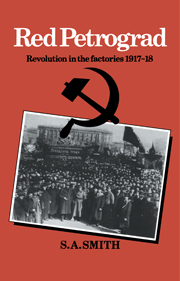Book contents
- Frontmatter
- Contents
- Acknowledgements
- Introduction
- 1 A profile of the Petrograd working class on the eve of 1917
- 2 The tsarist factory
- 3 The February Revolution: A new dispensation in the factories
- 4 The structure and functions of the factory committees
- 5 Trade unions and the betterment of wages
- 6 The theory and practice of workers' control of production
- 7 Deepening economic chaos and the intensification of workers' control
- 8 The social structure of the labour movement
- 9 The October Revolution and the organisation of industry
- 10 The economic crisis and the fate of workers' control: October 1917 to June 1918
- Conclusion
- Notes
- Bibliography
- Index
6 - The theory and practice of workers' control of production
Published online by Cambridge University Press: 11 January 2010
- Frontmatter
- Contents
- Acknowledgements
- Introduction
- 1 A profile of the Petrograd working class on the eve of 1917
- 2 The tsarist factory
- 3 The February Revolution: A new dispensation in the factories
- 4 The structure and functions of the factory committees
- 5 Trade unions and the betterment of wages
- 6 The theory and practice of workers' control of production
- 7 Deepening economic chaos and the intensification of workers' control
- 8 The social structure of the labour movement
- 9 The October Revolution and the organisation of industry
- 10 The economic crisis and the fate of workers' control: October 1917 to June 1918
- Conclusion
- Notes
- Bibliography
- Index
Summary
THE THEORY OF WORKERS' CONTROL
The whole subject of workers' control in the Russian Revolution is awash in confusion. There is not even an agreed theoretical definition of what constitutes ‘workers’ control of production'. Precisely what kinds of activities should we conceive as ‘workers’ control'? Can all the activities of the factory committees – which included struggles for higher wages, shorter hours and for the organisation of food supplies – be seen as part of workers' control? Soviet historians, such as V.I. Selitskii and M.L. Itkin, answer in the affirmative. Yet if one sees workers' control as relating to struggles over control of the production process, rather than struggles over the degree of exploitation, as argued in the introduction, then it becomes obvious that not all the activities of the factory committees can be subsumed into the category of ‘workers’ control'. Z.V. Stepanov is correct to define as workers' control only those measures, ‘implemented by proletarian organisations, and linked directly to intervention in the productive and commercial activity of the industrial enterprise, to the organisation of multilateral accounting and to control of the whole of production’. It is difficult to go beyond this rather vague definition. ‘Workers’ control' is not a concept which can be determined with great theoretical rigour, for in reality it took a plurality of forms, and changed radically in character within a short space of time.
- Type
- Chapter
- Information
- Red PetrogradRevolution in the Factories, 1917–1918, pp. 139 - 167Publisher: Cambridge University PressPrint publication year: 1983

